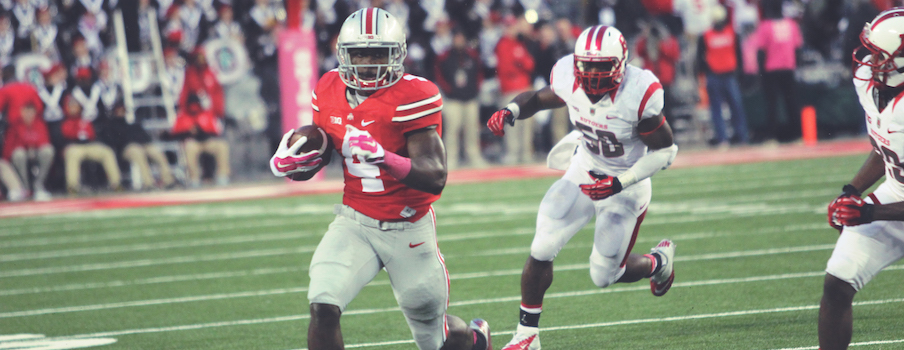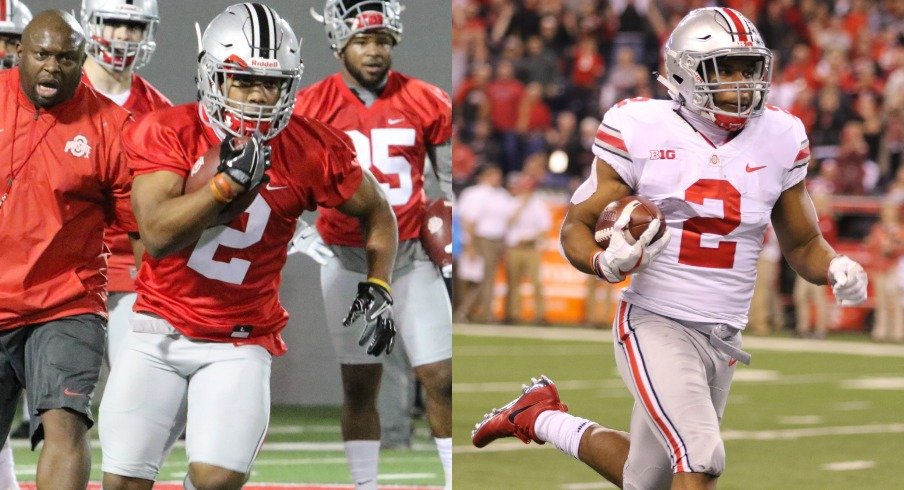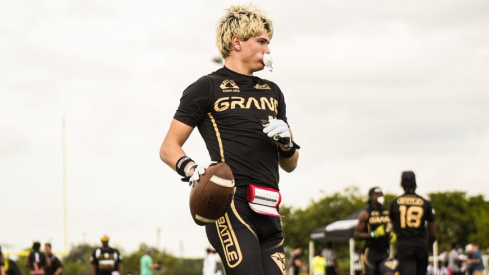A slew of new Ohio State football players have “officially become Buckeyes” over the past week.
Since last Wednesday, when linebacker Dallas Gant became the second member of Ohio State’s 2018 recruiting class to shed his black stripe, four other true freshmen have completed the team initiation ritual: fellow linebacker Teradja Mitchell, defensive tackle Taron Vincent, running back Brian Snead and wide receiver Chris Olave.
Defensive tackle Tommy Togiai – who, like Gant, was an early enrollee – was the first member of the class of 2018 to lose his black stripe, shedding his during spring practices.
The ritual – which dates back to when Urban Meyer first became a head coach at Bowling Green, and started at Ohio State in his first season as the Buckeyes’ coach in 2012 – serves as an unofficial line of demarcation for which Buckeyes have proven themselves ready to contribute to the team. While there’s no official criteria for having the black stripe removed – at least not that have been revealed to the public – it signifies that a player has been working hard, taking care of his business both on and off the field and doing what the coaches expect them to do.
As such, there’s reason to expect that the freshmen who lose their black stripes first are also the most likely to see significant playing time this upcoming season. History shows, though, that that’s not always the case.
It was the case last season, at least for the first freshman to lose his black stripe, as J.K. Dobbins went on start all 14 games for the Buckeyes at running back and break the school’s single-season freshman rushing record. Similarly, the first player to lose his black stripe during fall camp in 2016 – Michael Jordan – went on to start all 13 games at left guard for the Buckeyes that season, taking on an unusually prominent role for a true freshman.
There are other examples, though, of players who shed their stripes early but barely played as true freshmen; and conversely, players who shed their stripes later in camp but still went on to play significant roles in their first years on campus.
We take a look back now at who the first players were to lose their black stripes in each of the past six seasons, and how much that correlated with which freshmen became significant contributors in those seasons, before forecasting whether the first players to lose their black stripes this year have put themselves in position for significant playing time.
2017
When J.K. Dobbins became the first freshman to lose his black stripe last season, it certainly proved to be foreshadowing of his season to come. With Mike Weber sidelined at the beginning of last season, Dobbins started the Buckeyes’ season opener against Indiana, and performed so well – rushing for 181 yards – that he never relinquished the job, finishing the season with 1,403 rushing yards and seven rushing touchdowns.
Although Dobbins was the first freshman to lose his black stripe in 2017, he wasn’t actually the first member of the Buckeyes’ 2017 recruiting class to lose his black stripe; that honor went to cornerback Kendall Sheffield, who arrived at Ohio State as a redshirt sophomore transfer from Blinn College, who shed his black stripe in the spring. He too, though, parlayed his early stripe removal into immediate playing time, ultimately playing 626 total snaps – second-most among all cornerbacks – after appearing in all 14 games last season.
Of the freshmen, Dobbins was the only one who saw regular playing time with the first-team offense or defense last season, but there was a strong correlation between the other freshmen who lost their black stripes early and who saw the most playing time.
All five true freshmen who played at least 100 snaps last season – Dobbins, Jeffrey Okudah, Chase Young, Thayer Munford and Isaiah Pryor – were also among the first six freshmen to lose their black stripes. The other, Haskell Garrett, played 61 snaps in eight games.
The most notable exception to that rule was linebacker Baron Browning, who didn’t lose his black stripe until Sept. 21, yet played the sixth-most offensive or defensive snaps of any freshman (95) while also seeing playing time on special teams, appearing in every game but one.
2016
While the first player to lose his black stripe last fall, Jordan, was the true freshman who played the biggest role in 2016, the correlation between early stripe removal and early playing time otherwise wasn’t as strong two season ago.
Wide receiver Austin Mack actually became the first freshman to ever lose his black stripe during spring practice, since the tradition started at Ohio State, but he only saw occasional playing time in 2016, catching just two passes for 15 yards.
Linebacker Tuf Borland, the third true freshman to lose his black stripe in 2016, didn’t play at all that season, taking a redshirt year instead.
Meanwhile, the true freshman who played the biggest role that season outside of Jordan – defensive end Nick Bosa – didn’t lose his black stripe until nearly the end of the preseason (Aug. 25), though that was in part because he was still working his way back from a torn ACL.
2015
Only seven Ohio State freshmen lost their black stripes prior to the 2015 season, and that proved to be foreshadowing for the lack of freshman production the Buckeyes would have that season, when virtually no newcomers played significant roles on either offense or defense.
The first freshman to lose his black stripe that year, offensive tackle Isaiah Prince, was in fact the first freshman to see playing time in 2015. Otherwise, though, there wasn’t much correlation between which players lost their stripes early and which freshmen played early, as the only other freshmen to shed their stripes in August – Weber, wide receiver K.J. Hill and defensive tackle Robert Landers – all redshirted.
Eric Glover-Williams lost his black stripe on Sept. 4, three days before the Buckeyes’ Monday night season opener at Virginia Tech in 2015, but the only other two true freshmen who saw the field that season – linebacker Jerome Baker and cornerback Denzel Ward – didn’t lose their stripes until October.
2014
Curtis Samuel and Raekwon McMillan were the first two members of Ohio State’s 2014 recruiting class to lose their black stripes, and that did correlate to the season ahead, as they were the two true freshmen who played the biggest roles for the Buckeyes on offense or defense in their national championship season.
McMillan played in 13 of the Buckeyes’ 15 games that season, recording 54 total tackles, while Samuel played in all 15 games and gained 724 all-purpose yards as a runner, receiver and kickoff returner.

Darius Slade, the third freshman to lose his black stripe in 2014, took a redshirt. In total, though, seven of the first 10 freshmen to lose their stripes that year – Samuel, McMillan, safety Damon Webb, wide receiver Noah Brown, defensive end Jalyn Holmes, linebacker Dante Booker and wide receiver Johnnie Dixon (in only two games before taking a medical redshirt) – saw at least some playing time that season.
The other true freshman who played a big role that year, kicker Sean Nuernberger, didn’t shed his black stripe until one week before the season.
2013
This season of black stripe removals was famous for Joe Ramstetter, a walk-on wide receiver, being the first player to earn the ceremonial honor. That didn’t foreshadow for playing time for Ramstetter, however, who never saw the field for the Buckeyes.
The same was true for one of the next two Buckeyes to lose his black stripe that year, linebacker Mike Mitchell, who redshirted his freshman year and left the program after just one season.
Of the first five players to lose their black stripes in 2013, though, the other three did play roles for the Buckeyes as a true freshman. Dontre Wilson had 983 all-purpose yards as a rusher, receiver and returner; fellow running back Ezekiel Elliott had 262 rushing yards; and Joey Bosa burst onto the scene as an immediate starter at defensive end, recording 13.5 tackles for loss.
2012
The first freshman ever to shed the black stripe at Ohio State was Devan Bogard, who saw playing time on special teams in seven games as a freshman in 2012 before tearing his ACL.
Noah Spence, the second freshman to lose his black stripe in 2012, played in 11 games as a true freshman, recording 12 total tackles.
Each of the other first five players to lose their black stripes in 2012 saw playing time throughout their freshman years, too – defensive linemen Tommy Schutt and Adolphus Washington each played in 10 games, while Taylor Decker played in all 12.
Running back Bri’onte Dunn, the ninth player to lose his stripe in 2012, played in 11 games, carrying the ball 25 times for 133 yards.
There were also several true freshmen who saw playing time in 2012, though, that didn’t lose their black stripes until after the season started, including wide receiver Michael Thomas (11 games) and linebackers Jamal Marcus (11 games) and Joshua Perry and Camren Williams (10 games each).
2018 Outlook
The fact that Togiai and Vincent, Gant and Mitchell, Snead and Olave have already lost their black stripes is a promising sign for their chances to see meaningful playing time in 2018, as the freshmen who have shed their stripes first have certainly been more likely to play than those who haven’t.
Other factors come into play when determining which players will ultimately see playing time, though, and while all of them could push for a spot on the field in one phase of the game or another, there isn’t a clear-cut path to a huge role for any of them.
Togiai and Vincent are both talented enough to push for a spot in the defensive tackle two-deep, but they’ll have to beat out Davon Hamilton, Haskell Garrett and Jerron Cage for playing time behind projected starters Dre’Mont Jones and Robert Landers.
Ohio State’s linebacker rotation remains unsettled, but the Buckeyes have plenty of options at the position among returning players – including Tuf Borland, Malik Harrison, Keandre Jones, Baron Browning, Pete Werner, Justin Hilliard and Dante Booker – that will likely keep Gant and Mitchell out of the lineup as true freshmen, though they are both strong candidates to earn spots on special teams.
Snead’s apparent strong start to his first fall camp could be enough to push him ahead of fellow true freshman Master Teague – who had a strong spring, but is still wearing his black stripe – on the running back depth chart, but he’s still likely going to have to wait his turn behind J.K. Dobbins and Mike Weber this season.
Olave, similarly, plays a position where the Buckeyes are deep with returning players with experience. With all of the team’s top six wide receivers from last season back, plus Jaylen Harris, C.J. Saunders and Demario McCall also among those pushing for playing time, Olave will truly have to make a huge impression to crack the receiver rotation.
Meanwhile, the freshmen who the Buckeyes actually need to play the most might be among those who haven’t shed their stripes yet. Jeremy Ruckert is expected to see immediate playing time at tight end, Tyreke Smith could be a factor in the defensive end rotation and Josh Proctor is among those competing at safety, but all of them were among the 19 scholarship true freshmen who still had black tape on their helmets at the time of this article’s publication on Tuesday afternoon.


